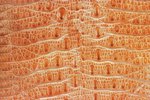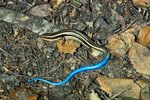Things You'll Need
Shovel
Aluminum siding
Aluminum fencing
Fruit or fresh fish
Monitor lizards are tropical animals that fall under the scientific family Varanidae. The biggest lizard, the Komodo dragon, is native to Southeast Asia. These lizards make terrific climbers, so building a trap to capture a monitor lizard involves using man-made materials which cannot be climbed by the lizards. Trapping a monitor humanely means using a trap, such as a hole in the ground, which does not pinch or otherwise harm the animal.
Dig a hole in the ground. This hole will vary in size; monitor lizards range in size from 1 foot long to 364 lbs. Dig the hole deep enough so the lizard cannot easily extend its leg and escape. The hole will need an extra 2 to 4 feet to fit the siding, which is slippery and nearly impossible for the lizard to climb.
Measure the circumference of the hole, then cut out the aluminum siding to match the circumference. Slip the siding into the hole so it lines the dirt on all sides. Push the siding into the ground, burying the ends so the lizard does not harm itself. The siding will need to be at least a foot under the ground. Trim the top of the siding to fall a foot below the top of the hole, burying the top end under the earth.
Insert the aluminum fencing into the ground at least 4 feet, beginning behind the trap and extending toward the lizard habitat or known area. The lizard will walk along this fence, trying to find a way around it, only to fall into the prepared hole. Lizards cannot climb slippery aluminum, so they will not be able to walk over the fence.
Place the bait into the trap. Some monitor lizards prefer fish while others prefer fresh fruit. Use one or both in the trap, depending on what type of monitor lizard you are trying to capture.
Remove trapped lizards quickly to avoid capture by other predators or exposure to undesirable weather conditions, such as extreme heat or rain.
References
Photo Credits
-
Jupiterimages/Photos.com/Getty Images
Writer Bio
Rebecca Mayglothling has worked directly with toddlers and preschoolers for more than three years. She has published numerous lesson plans online as well as parenting and teaching advice. She continues to keep ahead of parenting methods and is eager to share them through her professional writing.




